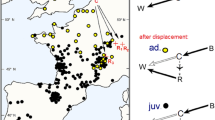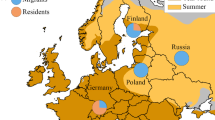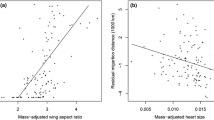Abstract
“Optimization is the process of minimizing costs or maximizing benefits, or obtaining the best possible compromise between the two. Evolution by natural selection is a process of optimization” (R. McNeill Alexander 1982).
Access this chapter
Tax calculation will be finalised at checkout
Purchases are for personal use only
Preview
Unable to display preview. Download preview PDF.
Similar content being viewed by others
References
Alerstam T (1979a) Wind as selective agent in bird migration. Ornis Scand 10:76–93
Alerstam T (1979b) Optimal use of wind by migrating birds: combined drift and overcompensation. J Theor Biol 79:341–353
Alerstam T (1981) The course and timing of bird migration. In: Aidley DJ (ed) Animal migration. Cambridge University Press, pp 9–54
Alerstam T (1985) Strategies of migratory flight, illustrated by arctic and common terns. Sterna paradisaea and Sterna hirundo. In: Rankin MA (ed) Migration: mechanisms and adaptive significance. Contrib Mar Sci Suppl 27:580–603
Alexander RMcN (1982) Optima in animals. Arnold, London
Andersson M. Norberg RA (1981) Evolution of reversed sexual size dimorphism and role partitioning among predatory birds, with a size scaling of flight performance. Biol J Linn Soc 15:105–130
Biebach H (1985) Sahara stopover in migratory flycatchers: fat and food affect the time program. Experientia (Basel) 41:695–97
Blem CR (1975) Geographic variation in wing-loading of the house sparrow. Wilson Bull 87:543–549
Butler RW. Kaiser GW, Smith GEJ (1987) Migration chronology, length of stay, sex ratio, and weight of western sandpipers Calidris mauri on the south coast of British Columbia. J Field Ornithol 58:103–111
Caraco T. Martindale S, Whittam TS (1980) An empirical demonstration of risk-sensitive foraging preferences. Anim Behav 28:820–830
Carpenter FL, Paton DC, Hixon MA (1983) Weight gain and adjustment of feeding territory size in migrant hummingbirds. Proc Natl Acad Sci USA 80:7259–7263
Charnov EL (1976) Optimal foraging, the marginal value theorem. Theor Popul Biol 9:129–136
Charnov EL, Orians GH, Hyatt K (1976) Ecological implications of resource depression. Am Nat 110:247–259
Cramp S, Simmons KEL (1983) Handbook of the birds of Europe, the Middle East and North Africa, vol 3. Oxford University Press, Oxford
Edelstam C (1972) The visible migration of birds at Ottenby, Sweden. Vår Fågelvärld, Stockholm
Ekman J, Hake M (1988) Avian flocking reduces starvation risk: an experimental demonstration. Behav Ecol Sociobiol 22:91–94
Enquist M, Pettersson J (1986) The timing of migration in 104 bird species at Ottenby — an analysis based on 39 years trapping data (English summary). Special Report from Ottenby Bird Observatory no 8, Ottenby, Sweden
Fransson T (1986) The migration and wintering area of Nordic spotted flycatcher, Muscicapa striata (English summary). Vår Fågelvärld 45:5–18
Gilliam JF, Fraser DF (1987) Habitat selection under predation hazard : test of a model with foraging minnows. Ecology 68:1856–1862
Glutz von Blotzheim UN, Bauer KM, Bezzel E (1975) Handbuch der Vögel Mitteleuropas, Band 6. Akademische Verlagsgesellschaft, Wiesbaden
Glutz von Blotzheim UN, Bauer KM (1982) Handbuch der Vögel Mitteleuropas Band 8/II. Akademische Verlagsgesellschaft, Wiesbaden
Glutz von Blotzheim UN, Bauer KM (1985) Handbuch der Vögel Mitteleuropas, Band 10/1. AULA-Verlag, Wiesbaden
Hedenström A, Pettersson J (1987) Migration routes and wintering areas of willow warblers Phylloscopus trochilus ringed in Fennoscandia. Ornis Fenn 64:137–143
Hildén O, Saurola P (1982) Speed of autumn migration of birds ringed in Finland. Ornis Fennica 59:140–143
Lima SL (1986) Predation risk and unpredictable feeding conditions: determinants of body mass in birds. Ecology 67:377–385
Lindström Å (1986) Fat deposition in migrating birds. Introductory paper no 44, Department of Ecology, University of Lund
Lindström Å (1989) Finch flock size and risk of hawk predation at a migratory stopover site. Auk 106:225–232
Moore FR, Simm PA (1986) Risk-sensitive foraging by a migratory bird Dendroica coronata. Experientia (Basel) 42:1054–1056
Murray GB Jr (1979) Fall migration of blackpoll and yellow-rumped warblers at Island Beach, New Jersey. Bird-Banding 50:1–11
Myers JP, Myers LP (1979) Shorebirds of coastal Buenos Aires province, Argentina. Ibis 121:186–200
Norberg RÅ (1981) Optimal flight speeds in birds when feeding young. J Anim Ecol 50:473–477
Page G, Middleton ALA (1972) Fat deposition during autumn migration in semipalmated sandpipers. Bird-Banding 43:85–96
Pennycuick CJ (1969) The mechanics of bird migration. Ibis 111:525–556
Pennycuick CJ (1975) Mechanics of flight. In: Farner DS, King JR (eds) Avian biology, vol 5. Academic Press, London, pp 1–75
Pennycuick CJ (1978) Fifteen testable predictions about bird flight. Oikos 30:165–176
Real L. Cararo T (1986) Risk and foraging in stochastic environments. Annu Rev Ecol Syst 17:371–390
Rudebeck G (1950–51) The choice of prey and modes of hunting of predatory birds with special reference to their selective effect. Oikos 2:67–88, 3:200–231
Salomonsen F (1967) Migratory movements of the arctic tern Sterna paradisaea in the Southern Ocean. Kgl Dan Vid Biol Medd 24 no 1
Schnell GD. Hellack JJ (1979) Bird flight speeds in nature: optimized or a compromise? Am Nat 113:53–66
Stanley PI, Minton CDT (1972) The unprecedented westward migration of curlew sandpipers in autumn 1969. Br Birds 65:365–380
Stephens DW, Krebs JR (1986) Foraging theory. Princeton University Press, Princeton
Summers RW, Waltner M (1978) Seasonal variations in the mass of waders in southern Africa, with special reference to migration. Ostrich 50:21–37
Tucker VA (1974) Energetics of natural avian flight. In: Paynter RA (ed) Avian energetics. Publ Nuttall Ornithol Club no 15, Cambridge Mass, pp 298–328
Veiga JP (1986) Settlement and fat accumulation by migrant pied flycatchers in Spain. Ringing & Migr 7:85–98
Videler JJ, Vossebelt G, Gnodde M, Groenewegen A (1988) Indoor flight experiments with trained kestrels. J Exp Biol 134:173–199
Walter H (1979) Eleonora’s falcon. University of Chicago Press, Chicago London
Author information
Authors and Affiliations
Editor information
Editors and Affiliations
Rights and permissions
Copyright information
© 1990 Springer-Verlag Berlin Heidelberg
About this paper
Cite this paper
Alerstam, T., Lindström, Å. (1990). Optimal Bird Migration: The Relative Importance of Time, Energy, and Safety. In: Gwinner, E. (eds) Bird Migration. Springer, Berlin, Heidelberg. https://doi.org/10.1007/978-3-642-74542-3_22
Download citation
DOI: https://doi.org/10.1007/978-3-642-74542-3_22
Publisher Name: Springer, Berlin, Heidelberg
Print ISBN: 978-3-642-74544-7
Online ISBN: 978-3-642-74542-3
eBook Packages: Springer Book Archive




